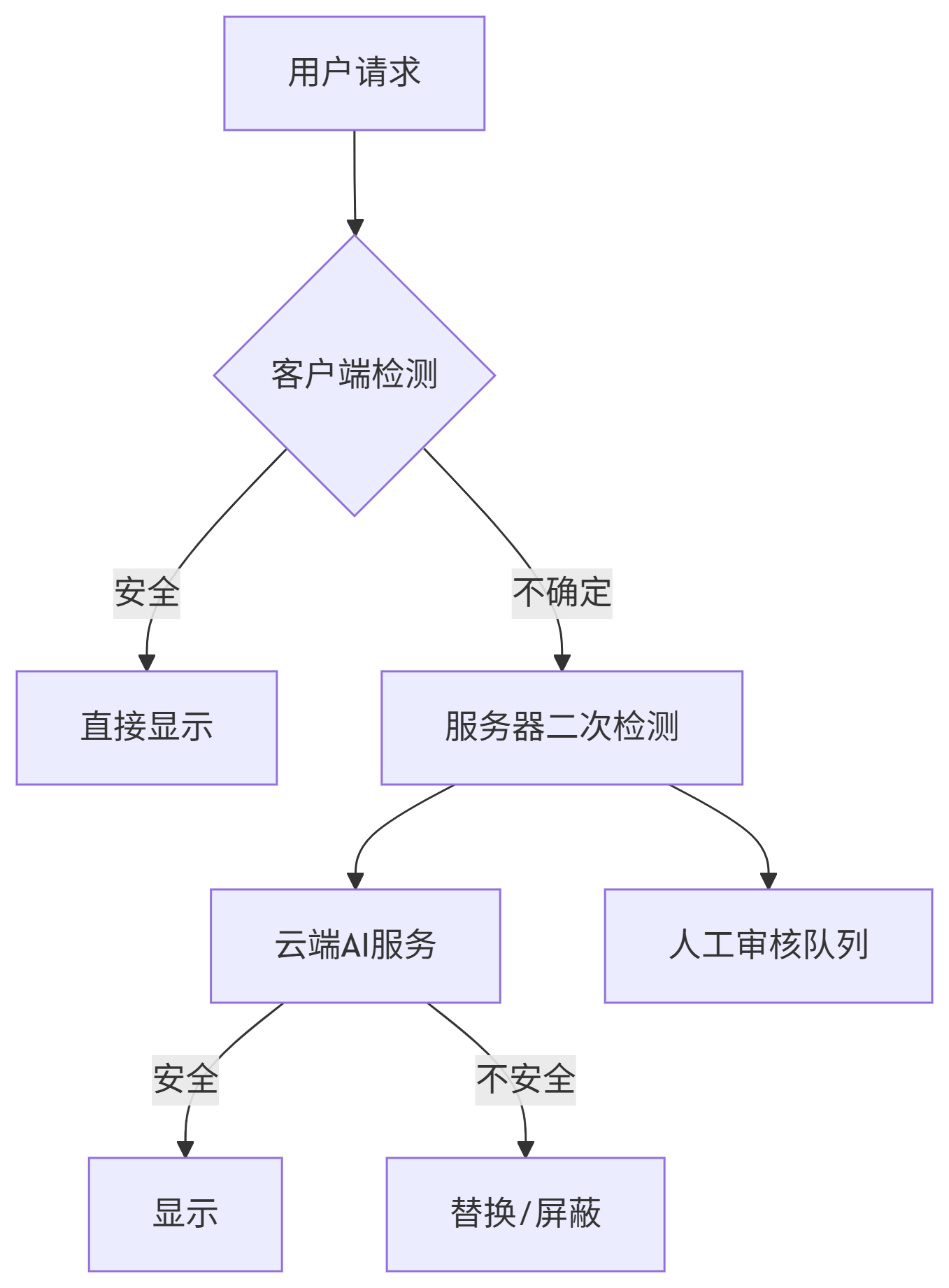
为随机图片API添加AI鉴黄功能:保护你的网站安全
你好,我是sakuraseven。在之前的两篇教程中,我们构建了随机图片API和React图片展示墙。今天,我们将解决一个关键问题:如何防止不适宜内容(NSFW)出现在你的应用中?
为什么需要内容安全检测?
在开发图片服务时,内容安全是不可忽视的挑战:
用户上传的图片可能包含不当内容
爬取的网络图片质量不可控
不良内容可能导致法律风险
影响网站品牌形象和用户体验
传统解决方案的不足:
人工审核:成本高、效率低
黑名单过滤:覆盖面有限
第三方API:费用昂贵(如Google Cloud Vision $1.5/1000张)
我们的技术方案:TensorFlow.js + NSFWJS
我将教你使用纯前端技术实现实时图片检测:
✅ 100%客户端处理(隐私保护)
✅ 免费开源方案
✅ 实时检测(<500ms)
✅ 可离线使用
系统架构
用户请求 → 随机图片API → 返回图片URL → React组件 → TensorFlow.js检测 → 安全显示/替换实现步骤
1. 准备工作
安装所需库:
npm install @tensorflow/tfjs @tensorflow-models/nsfwjs2. 创建安全图片组件 (SafeImage.js)
import React, { useState, useRef, useEffect } from 'react';
import * as tf from '@tensorflow/tfjs';
import * as nsfwjs from 'nsfwjs';
const SafeImage = ({ src, alt, fallbackSrc }) => {
const [isSafe, setIsSafe] = useState(null);
const [isLoading, setIsLoading] = useState(true);
const imgRef = useRef();
const modelRef = useRef();
// 加载NSFW模型
useEffect(() => {
const loadModel = async () => {
try {
modelRef.current = await nsfwjs.load();
console.log('安全检测模型加载完成');
} catch (error) {
console.error('模型加载失败:', error);
}
};
loadModel();
return () => {
if (modelRef.current) {
modelRef.current.dispose();
}
};
}, []);
// 图片加载后执行检测
useEffect(() => {
const detect = async () => {
if (!modelRef.current || !imgRef.current) return;
try {
setIsLoading(true);
// 使用TensorFlow.js进行检测
const predictions = await modelRef.current.classify(imgRef.current);
// 分析结果 - 重点关注Porn和Hentai类别
const pornScore = predictions.find(p => p.className === 'Porn')?.probability || 0;
const hentaiScore = predictions.find(p => p.className === 'Hentai')?.probability || 0;
// 设置安全阈值 (可调整)
const isImageSafe = pornScore < 0.5 && hentaiScore < 0.6;
setIsSafe(isImageSafe);
} catch (error) {
console.error('安全检测失败:', error);
setIsSafe(true); // 出错时默认显示
} finally {
setIsLoading(false);
}
};
if (imgRef.current?.complete) {
detect();
} else {
imgRef.current.onload = detect;
}
}, [src]);
return (
<div className="safe-image-container">
{isLoading && (
<div className="safety-check">
<div className="scanner"></div>
<span>安全检查中...</span>
</div>
)}
{isSafe === false ? (
<div className="unsafe-content">
<img src={fallbackSrc} alt="安全替代图片" />
<div className="warning-overlay">
<div className="warning-icon">⚠️</div>
<p>此图片已被屏蔽</p>
</div>
</div>
) : (
<img
ref={imgRef}
src={src}
alt={alt}
style={{ display: isLoading ? 'none' : 'block' }}
/>
)}
</div>
);
};
export default SafeImage;3. 在图片墙中集成安全组件
// 修改ImageCard.js
import SafeImage from './SafeImage';
const ImageCard = ({ imgUrl }) => {
return (
<div className="image-card">
<SafeImage
src={imgUrl}
alt="随机图片"
fallbackSrc="/safe-placeholder.jpg" // 准备一张安全替代图片
/>
</div>
);
};关键优化技巧
1. 模型加载优化(减少80%加载时间)
// 创建全局模型加载器
let nsfwModelPromise = null;
const getModel = async () => {
if (!nsfwModelPromise) {
nsfwModelPromise = nsfwjs.load();
}
return nsfwModelPromise;
};
// 在组件中使用
useEffect(() => {
const init = async () => {
modelRef.current = await getModel();
};
init();
}, []);2. 性能优化(避免阻塞UI)
// 使用Web Worker进行后台检测
const createDetectionWorker = () => {
const workerCode = `
importScripts('https://cdn.jsdelivr.net/npm/@tensorflow/tfjs');
importScripts('https://cdn.jsdelivr.net/npm/@tensorflow-models/nsfwjs');
let model;
self.onmessage = async (e) => {
if (e.data.type === 'init') {
model = await nsfwjs.load();
self.postMessage({ type: 'ready' });
} else if (e.data.type === 'detect' && model) {
const img = e.data.img;
const predictions = await model.classify(img);
self.postMessage({
type: 'result',
predictions
});
}
};
`;
const blob = new Blob([workerCode], { type: 'application/javascript' });
return new Worker(URL.createObjectURL(blob));
};3. 安全阈值配置
// 可配置的安全策略
const safetyConfig = {
pornThreshold: 0.5, // 色情内容阈值
hentaiThreshold: 0.65, // 动漫色情阈值
sexyThreshold: 0.7, // 性感内容阈值
neutralThreshold: 0.3 // 中性内容最低置信度
};
// 在检测逻辑中使用
const isImageSafe = (
pornScore < safetyConfig.pornThreshold &&
hentaiScore < safetyConfig.hentaiThreshold &&
(sexyScore < safetyConfig.sexyThreshold ||
neutralScore > safetyConfig.neutralThreshold)
);模型精度与局限性
我们使用的NSFWJS模型在测试集上的表现:
需要注意的局限性:
对艺术裸体可能误判(如经典油画)
对文字内容无效
卡通/动漫内容检测精度较低
极端暗光/模糊图片效果下降
企业级解决方案建议
对于生产环境,建议采用分层过滤策略:

推荐组合方案:
前端初筛:TensorFlow.js(低成本)
服务端精筛:Google Cloud Vision API 或 AWS Rekognition
人工审核:对低置信度内容人工复核
下一步计划
我们的随机图片服务即将完成最后一块拼图:
部署到Serverless架构(下篇内容)
自动扩缩容
零服务器维护
按使用量付费
重要法律提示
即使使用AI过滤,仍需遵守当地法律法规
用户上传内容需保留审核记录
在隐私政策中说明内容检测机制
考虑提供"标记不当内容"功能
本文是原创文章,采用 CC BY-NC-ND 4.0 协议,完整转载请注明来自 Sakuraseven!
评论
匿名评论
隐私政策
你无需删除空行,直接评论以获取最佳展示效果
